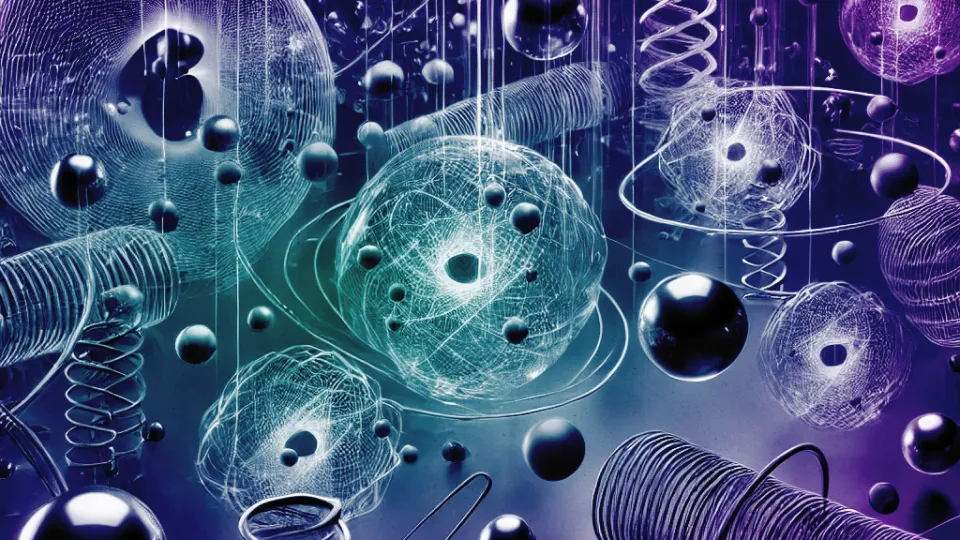Metals, Algae, and Solid Waste for Fuel Production
What can be used to produce fuel?

It is well known that electronics is based on electrons’ ability to carry charge, which generates an electric current. In contrast, in the relatively new field of spintronics, currents are generated by the electrons’ spin or magnetic moment. For a long time, it was believed this property manifested itself very weakly and was challenging to utilize experimentally.
In the 1980s, it was discovered that by carefully organizing materials, spin transport could be enhanced and even utilized. Scientists Albert Fert and Peter Grünberg created metallic heterostructures, alternating layers of ferromagnetic and non-magnetic materials. They found that such structures could exhibit strong magnetoresistance induced by a magnetic field [1]. This discovery was something fundamentally new: typically, metals in a magnetic field only change their resistance by fractions of a percent, making this property impractical for technical applications. However, in the work of Fert and Grünberg, resistance changed by tens or even hundreds of percent. This effect became known as “giant magnetoresistance,” and for its discovery, Fert and Grünberg were awarded the Nobel Prize in Physics in 2007.
Giant magnetoresistance, or GMR, occurs because a non-magnetic layer is placed between two magnetic layers, through which spin-polarized electrons are transported. The level of resistance depends on the orientation of the spin. Additionally, spin-polarized current can be “organized” so that the Coulomb, or charge, current is zero. In this case, Joule losses are also zero—which, under ideal conditions, leads to 100% efficiency. This addresses the primary challenge of modern electronics.
Thus began the history of spintronics—a branch of technology where the electron’s spin is used for various processes, from data storage to device switching. Spintronic-based devices are already being produced today. For example, every gadget—computer or smartphone—contains memory and a device to read information from that memory. In the past, inductive devices were used for reading data, but now engineers are utilizing spintronics.
Later, the development of magnetic memory began, but this also brought the first challenge. It turned out that controlling the magnetization of each heterostructure required excessive amounts of energy. Moreover, the proximity of metallic heterostructures affected their performance: the magnetic field of one structure would alter the magnetic field of its neighbour. However, in 1996, scientist John Slonczewski proposed that magnetization could be controlled not by a magnetic field but by spin-polarized electrons [2]. This effect became known as spin-transfer torque or STT. This discovery pushed spintronics another step forward.
Roman Morgunov: “I would call spintronics the daughter of electronics, not its sister. A sister implies equivalence and a similar structure. But children are often more advanced than their parents. Their minds are more complex, and they can develop more interesting ideas than their parents. In short, spintronics is a more sophisticated field of technology.”
In one year, Google uses as much energy executing user commands as the city of San Francisco consumes for lighting, heating, transportation, and other processes. The number of logical operations on the internet is only increasing: it’s predicted that by the 2040s or 2050s, the energy required for global information processing will be comparable to the power consumed by all other human activities combined [3].
According to different estimates, computing processes could consume up to 10 times the expected global energy supply by 2040 unless radical changes in technology and energy efficiency occur [4]. If the growth in the volume of operations cannot be stopped, reducing the energy consumed per operation is necessary. Additionally, the world is focused on the constant acceleration and improvement of processes: each new generation of computers, smartphones, and other devices is more efficient than the previous one. Breakthroughs in applied science drive these advancements.
Spintronics is also evolving in this context. For example, there is a gradual shift from using ferromagnets in this field. It was discovered that antiferromagnets could be used instead, offering advantages in speed and energy efficiency due to the faster ‘reconfiguration’ of the spin structure when spin-polarized current flows. This led to the emergence of yet another new field—antiferromagnetic spintronics.
Another example of new advancements in spintronics is related to the material used for the ‘interlayer’ between antiferromagnets and ferromagnets. In many heterostructures, platinum is a non-magnetic material [5]. The role of this material is to transport electrons while preserving their spin. Additionally, platinum, when in contact with a ferromagnet, itself becomes ferromagnetic. This means the interlayer between ferromagnetic layers becomes functional and can be ‘switched,’ enhancing the interaction between the layers. An even more promising material for these tasks could be palladium — a rarer and, therefore, less studied metal. Palladium has even more diverse and unique properties, and today, scientists are exploring it as an alternative to platinum. Researchers suggest that palladium’s ability to organize spins when in contact with a ferromagnet (proximity effect) and its capacity to maintain the spin orientation of conduction electrons over long distances may be greater than that of platinum.
In this way, spintronics is, in part, an experimental and diverse field with many research directions. But it is a necessary one. Right now, this field is creating its first “airplanes,” but in the future, it will build modern, fast, and widely available ‘aircraft.’ Research in spintronics is currently being conducted at the Mikron company in Zelenograd, at the Institute of Problems of Chemical Physics and Medicinal Chemistry in Chernogolovka, at the Far Eastern Federal University, at Crocus Nano Electronics, MIREA, MIPT, Moscow State University, Skolkovo, and other organizations.
In Nancy, France, the University of Lorraine partners with an industrial company that manufactures spintronic devices. Within this facility, a unique apparatus called the Tube has been constructed. It’s an 80-meter-long tube that houses various microdevices in a vacuum environment, such as deposition systems, analyzers, etc. The Tube is divided, with one-third allocated to the university and two-thirds to the production facility. Each student’s final project involves creating a spintronic device using the Tube’s capabilities.
The key feature of the “Tube” is that the vacuum inside and the concentration of all necessary equipment allow work on samples to be refined without damaging the materials. These conditions are essential for production but are typically unattainable in a laboratory due to the high cost of such setups. In normal conditions, any mistake by scientists would mean selecting new samples and starting the work over. Students at the University of Lorraine have a unique opportunity to work directly in a natural production environment.
Serial products based on spintronics are being manufactured around the world today. In Russia, memory technology development is being carried out by Crocus Nano Electronics, where spintronic technologies are responsible for reading information, storage, and writing. Spintronics is already being applied in biomedicine — particularly in cellular engineering — to create biomedical diagnostic and monitoring platforms, such as magnetoresistive (MR) biomolecular and biomedical platforms [6]. These devices can be used for conducting biological research at the molecular level, as well as for creating diagnostic chips and controlling biomedical prostheses.
The electronic compass is another well-known technological application of spintronics. Such a compass helps determine an object’s coordinates in space, tilt, and rotation. A device susceptible to the Earth’s magnetic field is required to solve this task. Unlike other technologies, spintronic devices can be vulnerable to magnetic fields while consuming little energy.
Magnetoresistive sensors based on spintronics are now available even in regular online stores. For hobbyists, they can be helpful for DIY projects — from simple compasses to advanced robotic systems with unique functions. These sensors can assist in mapping indoor spaces, exploring the environment, motor control, and more.
Thus, spintronics has long moved beyond pure academic science with delayed practical applications. Today, this “daughter” of electronics is used in various fields and promises to deliver even more breakthroughs soon—both in understanding physical processes and in the applicability of new materials and heterostructures for engineering projects. The only question is whether we wait for the next breakthroughs or join the effort alongside other researchers, scientists, and engineers.
This article was first published on PostNauka: https://postnauka.org/longreads/157461.
1. Fert, A. (2007) The Origin, Development and Future of Spintronics. Nobel Lecture. The Nobel Foundation
2. Slonczewski, J. (1996). Current-driven excitation of magnetic multilayers. Journal of Magnetism and Magnetic Materials, 159(1–2), L1–L7
3. Rebooting the IT Revolution: A Call to Action / Semiconductor Industry Association, 2015
4. Andrews, Justin L. et al. (2019). Building Brain-Inspired Logic Circuits from Dynamically Switchable Transition-Metal Oxides. Trends in Chemistry, Volume 1, Issue 8, 711–726
5. Morgunov, R. B., Bezverkhnii, A. I., Hehn, M., Bello, J. L., Fache, T., & Mangin, S. (2021). Dzyaloshinskii-Moriya interaction probed by magnetization reversal in bilayer Pt/Co/Ir/Co/Pt synthetic ferrimagnets. Physical Review. B./Physical Review. B, 104(13).
6. Freitas, P. et al. (2012). Spintronic platforms for biomedical applications. Lab on a chip, vol. 12,3: 546-57.

What can be used to produce fuel?

Physicist Seth Lloyd on quantum mechanics, classical vs quantum computers and the “universal digital computati...

Professor Ilya Nemenman on machine learning, the laws of biology, and the quest for a 'robot-scientist'